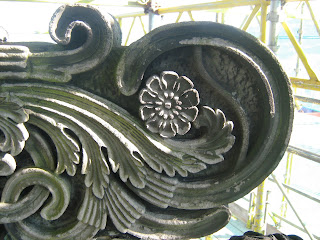Friday, 20 November 2009
Robert Adam's Bridewell on Calton Hill
Tuesday, 1 September 2009
Interesting research paper on the National Monument
Thursday, 6 August 2009
India and Calton Hill
Saturday, 1 August 2009
Research trip to India

During the month of June, I spent four weeks in India carrying out work with three specific goals:
1: To locate and record information that helps to understand the impetus behind of ex-patriot Brits in India organising and contributing to monuments in Great Britain during the late eighteenth and early nineteenth century.
2. To undertake a wider exploration of the question of nationality and the perception of being a Scot in the British Empire, by looking at what it meant to be a Scot in India during the time of the British Raj.
3. To continue on from the work carried out by the INTACH Trust awarded grant last year that surveyed the Scots Cemetery in Kolkata in forging further links between conservation and heritage professionals in the UK and India.
The first two objectives were achieved by viewing a wide and varied range of archival material in the National Library in Kolkata, the Asiatic Societies in Kolkata and Mumbai, the Mountstuart Elphinstone College in Mumbai, the libraries of the University of Mumbai and the Madras Literary Society in Chennai.
The results of this trip provided both archival and physical data from the remains of structures and monuments that can still be found within the Indian landscape. This data assisted in the understanding of monument commemoration and its use in developing propaganda to foster emulation and admiration in those responsible for the expansion of the British colonies, encouraging a sense of duty in expatriates based overseas for the benefit of the British Empire.
However, as monuments were also erected within the British Isles, by considering the purpose for monuments identified in India in a comparative study with the purpose of commemorative monuments in Scotland, and considering these two places within the context of part of the British Empire with their own separate cultural definitions to London, I was able to formulate theories on the overall purpose and importance of these structures during the nineteenth century. By preparing a case study on a monument instigated in India, yet built in Scotland, the psyche of the people behind the building and fundraising for these structures could be further explored in a more general sense regarding the importance of commemoration, not only in Scotland or India, but worldwide. The results of these ideas will form the basis for future research on these themes and much of the research has been integrated into my PhD work, which now has a whole chapter devoted to memorials and commemoration as a result of my Indian trip.
Further work is also in the process of being proposed for the future which will consider the role that India played in funding and influencing urban development in the UK in both the 19th and 20th centuries, and this is planned as post-doctoral research which is specified further below and will be refined throughout the course of the next eighteen months.
The remains of the British Imperial monuments and structures studied during my visit to India were not only important in the interpretation of their historic use, but also their use in the present day, where many of these structures and statues are now redundant. To consider how the conservation of these structures can be carried out, not only in a physical sense, but also theoretically, was an extremely educational and humbling experience. Many structures contain negative associations for Indians in the 21st century and this raised questions over the challenges found worldwide in conservation regarding the appropriateness of use, interpretation and protection.
To fulfil the third objective of my trip, I met with a number of architectural professionals and heritage bodies as I travelled through the country. This included institutions such as the West Bengal Heritage Society, Sir JJ School Of Architecture, Mountstuart Elphinstone College, Archaeological Survey of India, the University of Mumbai, The Indian Museum in Kolkata, and local INTACH departments. I also met with a number of conservation architects in Mumbai, Hyderabad and Kolkata to view and discuss recently completed and current conservation projects in action.
Since my return to the UK, this research and experience has inspired and motivated me to become further involved in cross-cultural collaborations regarding the architectural history of buildings in India and also their conservation and re-development in their current environment.
This has included projects such as:
Working with the World Monuments Fund by carrying out research on the Osmania Women’s College in Hyderabad, which the WMF are currently restoring.
Archival work on the Scottish Church College (AKA Duff College) in Kolkata, which has assisted in the preparation of potential conservation proposals for the building.
Setting up talks in Edinburgh by eminent Indian conservation professionals during their visits to the UK. Numerous conservation professionals and academics in Scotland have attended these and have began to set up their own contacts between the UK and India, for the pursuit of further academic and professional discourse.
Inspired by this last outcome, I have also recently set up an academic forum on Scots in India (http://scotsinindia.wordpress.com/). This is the start of a potential post-doctoral project, for which proposals for funding are already being considered. However, at present this forum aims to integrate work from academics and professionals, not only based in the UK or even in India, but worldwide, in order to bring together the work being carried out on the legacies found from Scots in India through art, architecture and society both in India and Scotland.
Tuesday, 21 July 2009
Book on the Buildings of Burford
Friday, 22 May 2009
SPP Consultative draft
Friday, 15 May 2009
Article for EWHT Journal
Sunday, 10 May 2009
Repairs to the Robert Burns Monument







